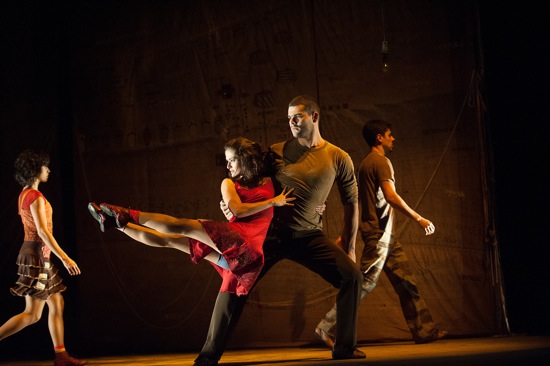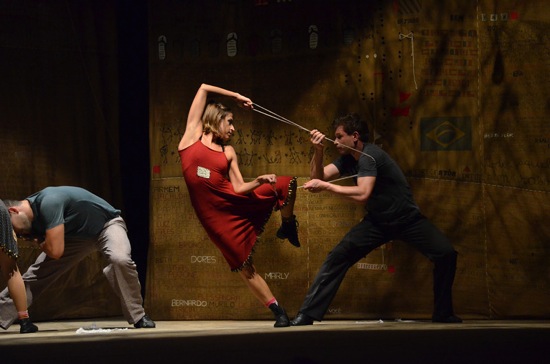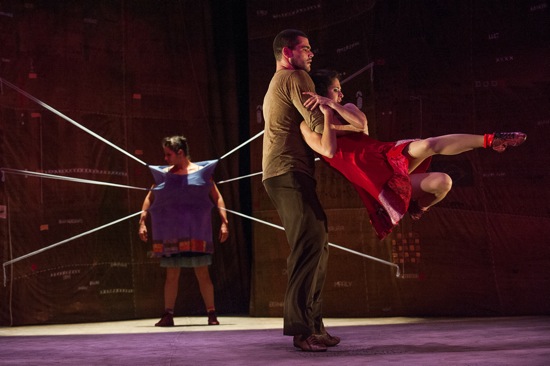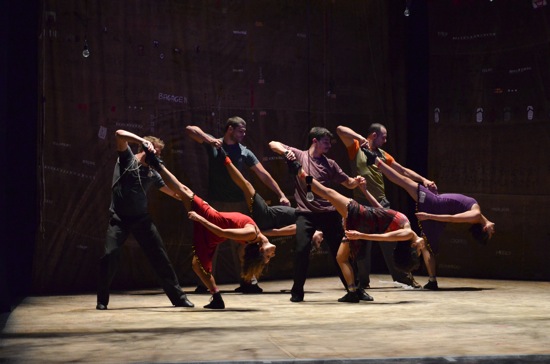
Nayane Diniz and Murilo Borges in Mimulus Dance Company’s Por Um Fio. At back, Fabiana Dias and Rodrigo de Castro. Photo: Christopher Duggan
The man leads. Right? In the social and ballroom dances of Europe and the Americas, the man always leads. Still, when you watch couples who are adept at, say, the Argentinian tango or the Viennese waltz, the man and his partner seem so bonded that you can envision them as complicit equals. Never mind that his right hand pressing on her back and his left arm pulling at her right arm are guiding her; power is disguised as a shared adventure.
The Mimulus Dance Company presents a different vision of what happens when two people dance together. During the opening week of Jacob’s Pillow’s 80th (!) Anniversary season, the Brazilian group led by choreographer-performer Jomar Mesquita performed Por Um Fio (By a Thread) in the Ted Shawn Theater. The 2009 piece, a tribute to the outsider artist Arthur Bispo de Rosário (1909-1989), celebrates the centenary of his birth and the 20th anniversary of his death.
Ed Andrade’s scenic design is based on the astonishing assemblages that Bispo do Rosário created during his 50 years in a mental hospital. Two wall-sized sheets of what looks like brown paper are sparsely covered with printed letters, straight and looping lines, and tiny white rectangles like light-switch covers. The delicate frenzy of tangled wires in an overhead sculpture and the ropes that the nine performers (all contributors to the choreography) pull out of the walls and concealed places on the floor allude to the artist’s work —often embroidery on fabric—and possibly also to the snarls in his brain. At one point, the formidable Juliana Macedo wears a black shirt covered with printing like those on the hangings. At another, performers spell each other in a game of cat’s cradle.
But the loops and tangles are also a major component of the dance style. Mesquita, who has done years of research into social forms both native and foreign to Brazil—samba, tango, salsa, lindy, and more, in all their regional variants—creates complex partner work in which the performers, holding both hands, coil their arms fluidly around each other’s bodies and necks, forming nooses and slipknots. If they were performing in the dark with phosphorescent paint on their arms, you’d see circles twisting and narrowing and widening. When Mesquita and Macedo execute the fascinating duet that they also presented at the Pillow’s opening gala, she compounds the tangles by holding one foot up to the back to create another opening. So silkily do these two splendid dancers execute the complications of their unstopping patterns that you see them as a single moving puzzle (like those with rings that you try to untangle).
Many of the adventures between a man and a woman in Por Um Filo, however, draw on salsa moves that show him as master and her as compliant—sometimes to the point of limpness. When Rodrigo de Castro first approaches Andrea Pinheiro as she stands waiting, he turns her by a firm hand on her head, and she bows and bends to keep the maneuver looking smooth and unabusive. But this happens often in the dance, performed by others as well (sometimes quite rapidly, as if the woman’s head were a crank). De Castro also bends Pinheiro back and, supporting her by a hand placed under her neck, swings her back and forth. Call it extreme salsa.
Even though I admire these ingeniously slippery negotiations, my kinesthetic sense (as well as my feminist sensibility) kicks in whenever a guy manipulates his woman by her head. Or when Fabiana Dias crawls onto the stage on her belly, with Lucas Verissimo moving her along by pushing her feet with his feet as he walks. Or when Murilo Borges slings Nayane Diniz around as in a Lindy, but with such complexity and at such a speed that she begins to look like a rag doll.
Macho power displays of another kind appear but have no consequences; like art objects up for auction, they’re shown, then set aside. Mesquita stitches a snaking pattern of black cord on Macedo’s white t-shirt while she waits; a few minutes later, he pulls it out again. Later she enters and stands staring straight ahead; he draws ropes out of the set, attaches them to points on her dress and makes them taut, so that she resembles an anesthetized fly in a spider web. Then she slips out of the garment, and after a while Dias rises up into it. The cords are yanked loose from the walls, and Dias dances with her partner, trailing them.
The music quicksteps between the festive and the soulful. Here a tango, there a samba. Now it’s Freeworm, now Chopin, now Caetano Veloso or one of several other Brazilian musicians. The rhythmic drive is infectious, and some of the passages of dancing have a party-time zest. The women sport a variety of outfits by Baby Mesquita that include colorfully patterned everyday dresses; short, slim, strappy ones with shiny beading around their hems; and longer full skirts. Their feet are shod in little dance boots. In one light-hearted sequence, the men vie to see which of them can carry the greatest number of his friends, some of whom jump on him without warning. The choreographer wins—presenting himself for several seconds festooned with all four women and the fifth man, Alexandre Tadra.
Por Um Fio’s dark side keeps creeping in though. The dancers are seldom all onstage at the same time. They enter, slip into an ongoing pattern, branch out, exit. There’s a sense of impermanence, as if this place were a club with other rooms; sometimes Rodrigo Marçal’s lighting turns the “walls” translucent, and behind them loom the performers’ enlarged shadows in another kind of dance. Little light bulbs hang from cords; the performers pull them down, seemingly at random, until they almost touch the floor; they rise unaided. Occasionally these swinging lamps are the only light onstage. Dias stands for a long time under a single red one, turning and turning.
After the dancers have bowed to ecstatic applause, they cut loose—improvising, repeating favorite moves. Even if you’re disturbed by the implicit misogyny of the danced messages, you have to love these nimble messengers.




Very compelling review Deborah – sounds fascinating, a work I’d probably enjoy (I have a ballroom background so I love strong partnering works). I’ve got to get up to Jacob’s Pillow this summer.